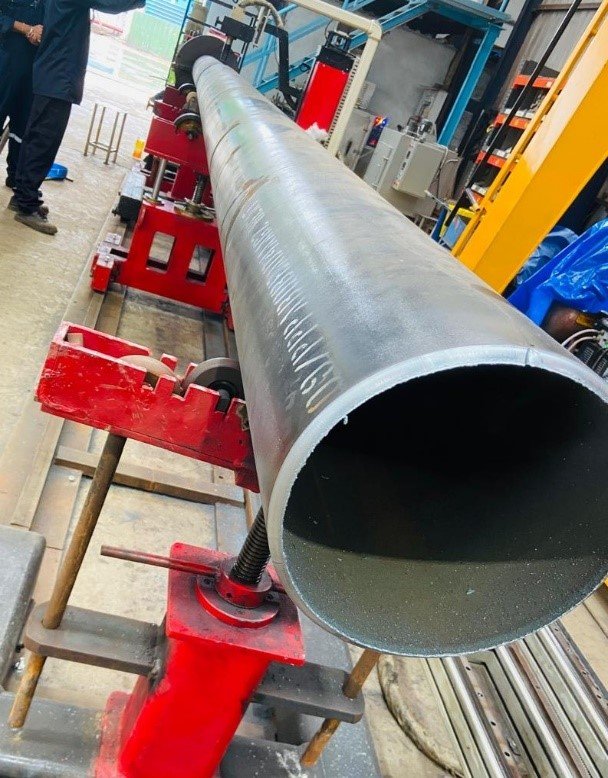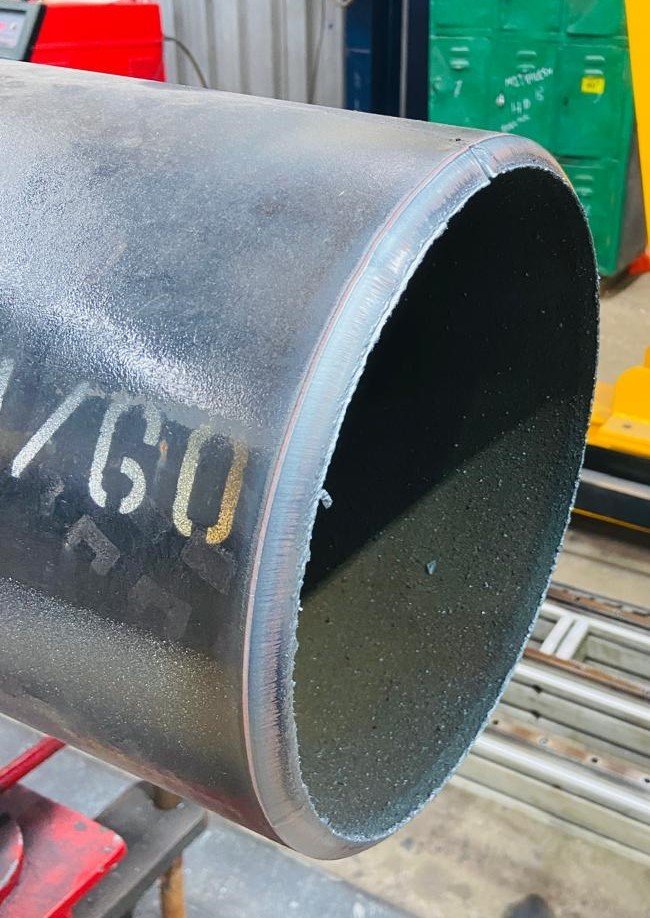The process of cutting and shaping of pipes as per required designs using special tools and techniques is called PROFILE PIPE CUTTING. This process is crucial in various industries, including construction, manufacturing, and oil and gas.
In this method a high-powered laser beam is used to melt, focus and vaporize the material of the pipes with precision and accuracy.
Pros: High precision, speed and no material contamination are some of the advantages of Laser Cutting.
Cons: High equipment costs and energy consumption are few disadvantages.
Employs a plasma arc (high power arc between electrode and metal) to melt the material and a heated gas stream is used to blow of the molten metal thus cutting the metal.
Pros: Plasma Cutting is well suited process for huge pipes with thickness more than 10mm. The initial equipment cost is also relatively less.
Cons: It’s not very clean process ad may require post clean-up process
Utilizes a high-pressure water jet to cut through pipes, ideal for sensitive materials.
Pros: High precision, clean cuts and cold-cutting process that doesn’t generate heat input to the part, so it eliminates the risk of thermal distortion or changes in material properties.
Cons: High Cutting Time, In-efficiencies and high initial costs are few limitations of this process.
Involves using mechanical tools and CNC controlled systems for cutting pipes.
Pros: High precision, clean cuts and variable depth in cuts can be achieved in this process.
Cons: High initial and maintenance cost. Selection of right kind of tools is a tedious job.
Below is the study of the automation made for pipe profile cutting by APS welding.
Auto Adjustment of torch angle: Torch should be auto calibrated to 0 degrees and the cutting angle should be set with respect to the same axis.
Y axis movement control: The Y-axis movement of the torch should be controlled using proximity sensors to avoid collisions and malfunctioning of automation
Auto distance adjustment between two cuts: The automation should be capable of maintain the fixed distance between the cuts.
| Index | PARAMETER | Range | LC/DEFAULT | Units |
|---|---|---|---|---|
| 1 | Run in Speed | 00.0 - 10.0m/min | 0.5m/min | m/min |
| 2 | Run in Distance | 02.0 - 25.0mm | 0.5mm | mm |
| 3 | Run in Direction | 0 - F/1 - R | 0-Right | LFT/RHT |
| 4 | Vertical Speed | 0.00 - 1.20m/min | 0.05m/min | m/min |
| 5 | Pierce Height | 01.0 - 25.0mm | 0.5mm | mm |
| 6 | Cut Height | 01.0 - PIERCE_HEIGHT | 0.5mm | mm |
| 7 | Cut Angle | -90 to +90DEG | 1 Deg | deg |
| 8 | Pierce Delay | 00.0 - 25.0 | 0.1s | s |
| 9 | Job Length | 00000 to 12000mm | 1mm | mm |
| 10 | Straight Distance | 00.0 - 25.0 | 0.1mm | mm |
| 11 | Angular Speed | 1 - 10 | 1deg/sec | DEG/SEC |
| 12 | Jog Distance | 00000 to 12000mm | 1mm | mm |
The automation auto calibrates itself going to its initial position at 0 degree and top of the Y axis movement for next cutting.
Torch can sense the surface of the pipe with the help of sensor and maintains the cut height according to the input data, for accurate and precision cutting.
The cutting ARM auto travels to the next cut point as per the given length of the job.
Run-In-Distance is the distance travel by the torch after doing the pierce Hole to cut the actual profile of the pipe. Hence, automation allows you to set a run-in distance up to 25mm.
Job Specifications:
Pipe Outer Diameter: 12in
Pipe Thickness: 10mm


Pipe profile cutting is a vital process in various industries, offering accuracy, efficiency, flexibility, and quality. By choosing the appropriate cutting method, businesses can optimize their production processes and produce high-quality products using various automations.
We have successfully installed the automation and are able to cut thicknesses ranging from 5mm to 15mm.
The Cut quality achieved is satisfactory with minimum after cut operations requirement

Article written by Vruthik Patel (Design Engineer – APS Welding)
APS welding is always ready to help you. For Sales Enquiries:Contact: +91 9601 444 111For booking service call:Contact: +91 9601 444 222
We design and manufacture all our products and thus we know the best about our products.
We are able to offer international technology and service at optimum prices.
Our team is regularly trained for updates in service techniques and also are constantly update on knowledge and skill.
We ensure you professionally managed sales and after sales support.
Office & Manufacturing Facility:
Survey No 172/1, Paikee 2, OLD GIDC Gundlav, Valsad, Valsad District, GUJARAT – 396035. INDIA.